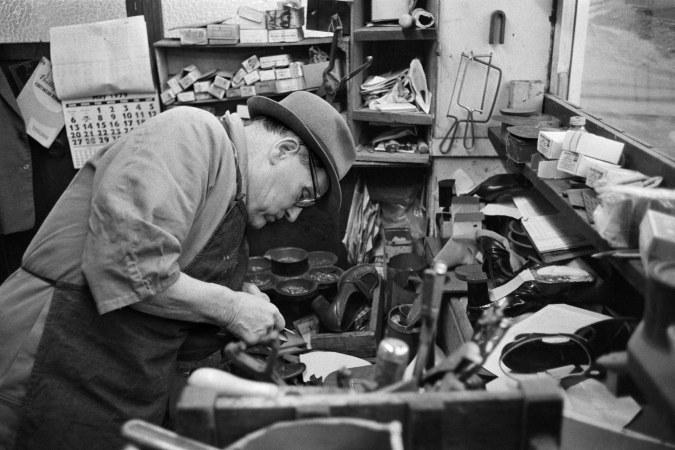
His craft is based in the notion that things of quality are meant to be fixed, even repeatedly, rather than discarded and replaced. Photograph by Martin Parr / Magnum
There were the hiking boots I’ve had since high school, so battered that one Sunday, near the Delaware Water Gap, the rubber sole started to crumble off in chunks. There were the short brown riding boots, perforated like brogues, that remained beloved even with a gash worn through the leather at the heel. There were the teal-blue pumps with a decorative buckle on the toe, made by an upscale French designer and borrowed, without total permission, from a friend’s sister, for a twenty-first birthday party. Those came home flecked with my roommate’s vomit, a peel of leather dangling from the toe.
I brought each pair to my cobbler, a cheerful Italian who roots for the Rangers and likes to share pictures of his son, now in grade school. Not all of them could be salvaged (that shred of leather couldn’t be reaffixed) but, for the most part, he takes my shabby, downtrodden shoes and returns them intact, supple, sturdy. He found a patch of leather to bandage that hole and ordered new Vibram soles for my hiking boots. That was six years ago. I plan on taking them to Idaho this summer.
A shoe is your most basic vehicle, the means of transport for nearly every experience outside of your own home. My shoes had conveyed me through alpine meadows and canyons, carried me to job interviews and in pursuit of a new life abroad, or borne the abrasion of countless miles of New York City sidewalk. Reinvesting in a pair that has accompanied you so far already can feel redemptive, loyal to your inner self.
Not that your cobbler will always approve. He (in my experience thus far, my cobbler has always been a he) will turn your shoe over in his skilled hands, inspecting how far down you’ve allowed the heel to wear. He’ll gruffly twist the sole, as if to wring it out, to test its integrity. He’s apt to take a piece of chalk or a grease pencil to mark the balls and heels of each shoe, to transform it into a blueprint for reconstruction. You’ll strain not to snatch it back, to tell him to be gentle, to tell him not to pull back the sole, even if it is already coming apart. Some shoes he’ll pronounce too far gone. Or he’ll name a price startlingly close to the amount you paid for them to begin with. There is implicit criticism in his assessments, as if you have erred by thinking that you could wear these shoes (leather boots in the rain, wafer-thin sandals without a rubber sole, stilettos to a farmhouse wedding) without ruining them. But don’t see your cobbler as your adversary. He’s your trusty, if harsh, adviser. He can keep the appearance of penury at bay…
Read the whole post here.